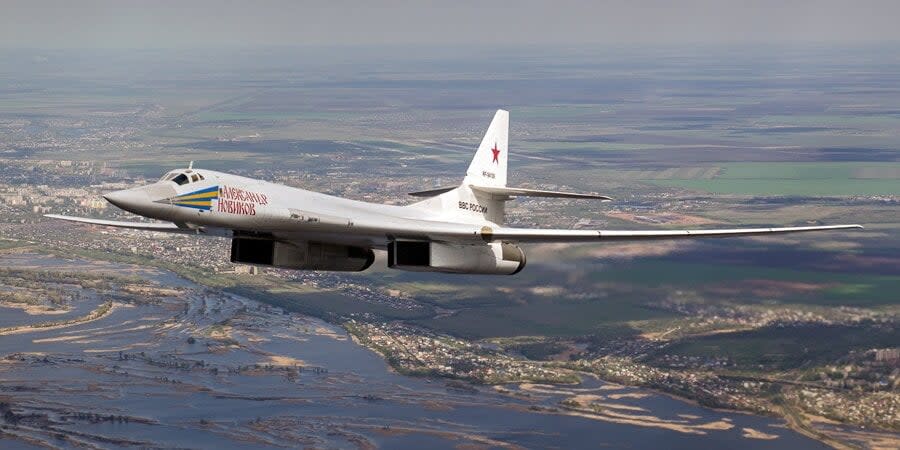What a defector engineer from Russia can tell the U.S. about Tu-160 strategic bombers

As NV has previously written, this was first reported by Yahoo News, referring to information from anonymous sources in the U.S. government.
According to this unconfirmed report, the engineer and his family entered the United States from Mexico at the end of December 2022, saying that he was one of the Tu-160’s engineers at the plant in Kazan.
Claiming that he had “important information for the U.S. government,” the man explained his move by saying that he was afraid of persecution for participating in protests in support of Russian opposition leader Alexei Navalny.
The journalists did not release the alleged defectors name, but their FBI and other law enforcement sources have reportedly confirmed his identity.
Judging by Russian media reports, the Tu-160M variant – the first strategic supersonic bomber and missile carrier to be built completely in Russia – made its debut flight a year ago. The Americans are first and foremost interested in whether the modernized strategic aviation of the Russian Federation can carry hypersonic weapons.
Secret information
Citing its sources, Yahoo News reported that the Russian engineer worked on the Tu-160 from 2018 to 2021.
This aircraft was adopted by the USSR army in the late 1980s, and today it is the most modern missile carrier in Russia’s strategic aviation fleet.
After the collapse of the USSR, the Ukrainian Air Force received 19 Tu-160s, but by 2000, these air-craft were disposed of as part of the American disarmament program, and also transferred to Russia as payment for natural gas.
Today, the Tu-160 and other strategic bombers are being used by Russian troops to launch cruise missiles to strike Ukraine.
“The aircraft can carry up to six Kh-55SM ground-attack cruise missiles, each with a 200 kiloton thermonuclear warhead, or Kh-555s armed with a conventional high-explosive fragmentation warhead,” writes Kyle Mizokami, who writes about defense and security issues for Popular Mechanics.
"As a carrier of cruise missiles, the Tu-160 usually flies at a speed of 940 km/h and at an altitude of up to 12 km. The bomber can also penetrate enemy airspace at low altitudes, flying at speeds in ex-cess of 1,000 km/h and using collision avoidance systems.”
According to him, there are at least 17 Tu-160s, built at least 34 years ago, in service today with the Russian Aerospace Forces. In 2014, the Kremlin launched a modernization program for these bombers and planned to produce 40 to 50 of the new Tu-160s.
It is extremely important for American intelligence agencies to obtain information about what engines these aircraft will receive and how their performance characteristics will change.
So far, it is known that the latest version of the Tu-160M is equipped with new navigation systems, new satellite communications equipment, a modified glass cockpit, and other components. The new generations of Tu-160 are designed for 40 years of operation.
Since the Tu-160 is part of the Russian "nuclear triad", it is also important for the U.S. military leader-ship to know what weapons systems new versions of this strategic bomber can carry.
This first and foremost concern is the hypersonic X-47M2 Kinzhal missile system. According to its declared characteristics, the Kinzhal is Russia’s most competitive weapon in relation to similar systems from the United States and China.
The missile’s speed is presumed to exceed 14,500 km/h, and it can be carried by the MiG-31K super-sonic fighter-interceptor, the Tu-22M3M strategic bomber, and most likely its relative, the Tu-160. There are also presumed to be ground-based Kinzhal launchers, although the exact number of these missiles in service with the Russian army remains unknown.
If the MiG-31K can carry a maximum of one hypersonic missile, according to some reports, up to eight Kinzhals can be loaded onto the upgraded version of the Tu-160 (four on each of two drums).
A number of outlets have reported that a Kinzhal missile fell near the city of Stavropol on September 14, 2022, about 350 kilometers from the border with Ukraine. Among the possible reasons is a technical malfunction of the rocket’s engine on its way to attack a target in Ukraine.
Strategic aviation of the Russian Federation
As of today, Russia's strategic bomber fleet consists of 125 aircraft, including 66 Tu-95s, 42 Tu-22Msand 17 Tu-160s.
These aircraft are located at air bases in the Saratov, Ryazan, and Kursk Oblasts, which were hit by strikes by the Ukrainian military in December 2022.
The most outdated bomber is the Tu-95, which still uses turboprop engines. Nevertheless, it is still an extremely dangerous and powerful weapon which the Russians have repeatedly used to launch cruise missile strikes at Ukraine from the Caspian Sea and from Russian territory.
The Tu-160 can carry up to 12 modern X-101 cruise missiles (with a warhead mass of more than 400 kg and a flight range of up to 5500 km) in its internal compartments, while the Tu-95 can carry up to eight such missiles on an external platform.
The Tu-95 can also carry up to three obsolete Kh-22 cruise missiles, which was the type used to destroy a residential building in Dnipro.
The main mission of these aircraft remains the launch of long-range cruise missiles with nuclear war-heads. According to the Russian state corporation Rostec, two more Tu-160M missile carriers were sent for flight tests in December 2022.
We’re bringing the voice of Ukraine to the world. Support us with a one-time donation, or become a Patron!
Read the original article on The New Voice of Ukraine

